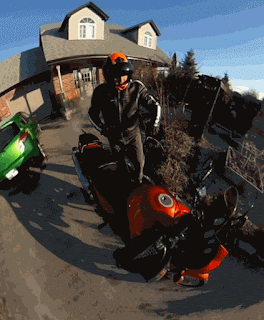Recently, my son was undergoing his IPRC process to enter high school and I’m suddenly privy to how parents experience this aspect of the public education system. The parties at this meeting seemed to genuinely have my son’s best interests at heart, but there are unseen forces in the education system more interested in saving money than promoting pedagogy.
One such area is technology support for IEPed students. The goal here is to provide digital tools that allow students with special needs to keep up with their class work. In many cases this can mean something like a Chromebook, which is essentially a web browsing laptop. I’m not a fan of Chromebooks, they are a corporate means of collecting users into a closed ecosystem. The intent of Chromebooks is to pass any online experience through Google’s corporate lens (Chrome) and to keep people within that singular view in order to benefit what is very much a for-profit business.
Google struggles to treat education and students in particular as anything other than a commodity because people’s internet attention is why Google is one of the richest companies in the world. Google is very aggressive about maintaining its monopoly which is why I’m reticent about things like GAFE, evangelizing groups like Google Certified Teachers and the Chromebooks.
 Google is a powerful tool, no doubt, but if it’s the only way you ever interact with digital technology then you aren’t particularly digitally fluent, any more than you could call yourself truly literate and knowledgeable if you only ever read one publisher’s books.
Google is a powerful tool, no doubt, but if it’s the only way you ever interact with digital technology then you aren’t particularly digitally fluent, any more than you could call yourself truly literate and knowledgeable if you only ever read one publisher’s books.
The default response from the school board when we began talking about replacing my son’s very old (he takes good care of it) laptop was to give him a Chromebook. Since we only pay lip service to developing digital fluency in Ontario and graduate a large majority of digital illiterates, this seems like a cheap and easy way to hand out tech, but in this case it is a kid who is already digitally skilled and who intends to make computer technology his life’s work. He is already competing in robotics competitions and building computers. The courses he has signed up for in high school focus on digital engineering. Giving him a Chromebook is like giving a carpenter a toy hammer and expecting them to frame a house. It’s neither individually appropriate nor particularly useful.
 I have been pushing to get him the tools that he needs to pursue his interests, but I’m speaking for the trees here as well as for my own son. I teach computer technology and have a high preponderance of ASD students who have a great interest in and a neuro-atypical approach to technology that allows them to tackle it in interesting, unique but usually never time efficient ways. Handing any of those students a Chromebook is like giving a mechanic a twelve millimeter wrench and then telling them to disassemble an engine with it, in an hour.
I have been pushing to get him the tools that he needs to pursue his interests, but I’m speaking for the trees here as well as for my own son. I teach computer technology and have a high preponderance of ASD students who have a great interest in and a neuro-atypical approach to technology that allows them to tackle it in interesting, unique but usually never time efficient ways. Handing any of those students a Chromebook is like giving a mechanic a twelve millimeter wrench and then telling them to disassemble an engine with it, in an hour.
When he is learning electronics next year in grade 9, he’ll need to install Arduino on his computer and then use it to code circuits. It’s free on a ‘proper’ computer running Windows, Linux or OSx, but Arduino can only be done on a Chromebook with a monthly fee (not covered by the school board). If he wants to run RobotC for his robotics classes, he can’t do it on a Chromebook. If he wants to run 3d modelling software? Code in the IDE of his choice? Run the plasma cutter software? Sorry, none of those happen on a web browser. If all we’re aiming to do is teach kids how to browse the internet like the consumers we want them to be and through a single, corporate lens, then we’re doing a great job pitching Chromebooks at them.
 A Chromebook isn’t cheaper than a basic Windows laptop. It is only a browser whereas the Windows PC can install a massive ecosystem of programs for a wide variety of purposes. The only advantage is that the Chromebook is easier to manage. Because you can’t install anything that isn’t a simplistic Chrome extension on it, you have less headaches with software conflicts; it does less, is easier to manage and does a great job of performing it’s primary function: feeding the Google data mining machine with much needed fuel. Pedagogy designed to expand digital fluency in our students isn’t the reason why Chromebooks are now ubiquitous. Management of educational technology is easier if you drink the koolaid and get on the magic Google bus where you don’t have to worry about all that messy digital diversity and the complications of actually teaching students (and teachers) how technology works. Google (and Apple, and Microsoft) are happy to usher your classroom in to a closed system for your own ease of you, learning how technology works be damned.
A Chromebook isn’t cheaper than a basic Windows laptop. It is only a browser whereas the Windows PC can install a massive ecosystem of programs for a wide variety of purposes. The only advantage is that the Chromebook is easier to manage. Because you can’t install anything that isn’t a simplistic Chrome extension on it, you have less headaches with software conflicts; it does less, is easier to manage and does a great job of performing it’s primary function: feeding the Google data mining machine with much needed fuel. Pedagogy designed to expand digital fluency in our students isn’t the reason why Chromebooks are now ubiquitous. Management of educational technology is easier if you drink the koolaid and get on the magic Google bus where you don’t have to worry about all that messy digital diversity and the complications of actually teaching students (and teachers) how technology works. Google (and Apple, and Microsoft) are happy to usher your classroom in to a closed system for your own ease of you, learning how technology works be damned.
In discussing this issue with the school board I was told that my son doesn’t need a full laptop because the specialty classes that require that software will supply it in class. His IEP specifies that he be given extra time to complete work, but that is impossible if the technology needed to do his class work is only available in a particular classroom. How does that help him finish his work after school, or on a weekend? It doesn’t help him if he is trying to do work during his GLE support period either because other students are using the in-class equipment while he is elsewhere. There is no guaranty that the technology would be available at lunch or before or after school either, so the ‘what he needs will be in the classroom’ answer seems to be intentionally ignoring the extra time his IEP clearly states he needs.
 Differentiation of assistive technology with an eye on customizing it to specific student needs is exactly what the IEP (INDIVIDUAL education plan) is supposed to be doing. If we were going to begin to take digital fluency seriously, assistive digital technology that encourages a diverse digital ecosystem and renders a wider understanding of how technology works would be a great place to start, especially with digitally interested students.
Differentiation of assistive technology with an eye on customizing it to specific student needs is exactly what the IEP (INDIVIDUAL education plan) is supposed to be doing. If we were going to begin to take digital fluency seriously, assistive digital technology that encourages a diverse digital ecosystem and renders a wider understanding of how technology works would be a great place to start, especially with digitally interested students.
A Chromebook should be the last thing suggested. This, or course, begs the question: if Chromebooks aren’t any cheaper and don’t improve digital fluency, why are we using them at all? Well, it makes our monopolistic corporate overlord, um, partner, happy while not being any cheaper and doing less, but it sure is easier to manage.
Whoever this is a win for, it isn’t providing my son with the technology he needs to succeed. It also puts pedagogy of promoting an understanding of the technology we’ve made an intrinsic part of our classrooms on the back foot. As near as I can tell, other than feeding a corporate partnership and rolling out something so simple it can’t really break (or do much), there is little to recommend the Chromebook, especially as an assistive device for a student who will need things it can’t do in his classes next year.
from Blogger http://ift.tt/2CZrpth
via IFTTT














